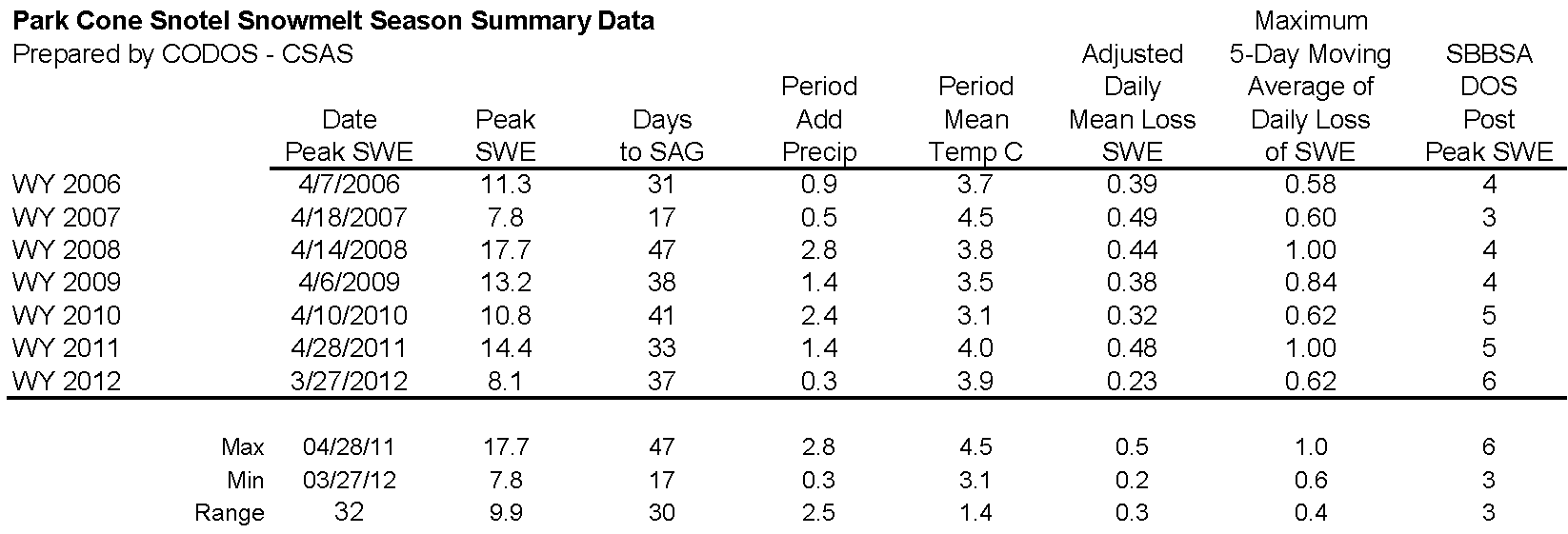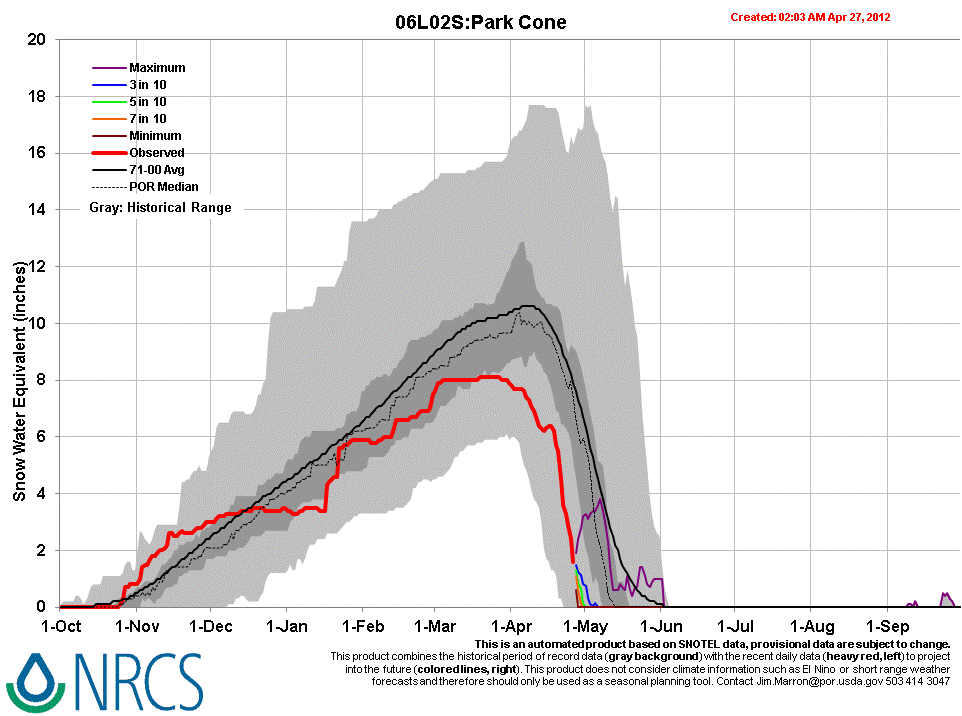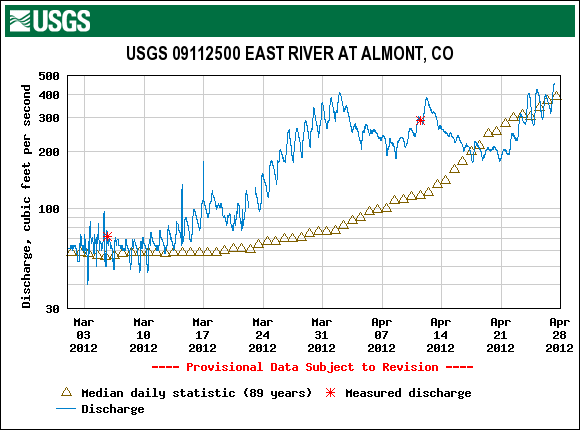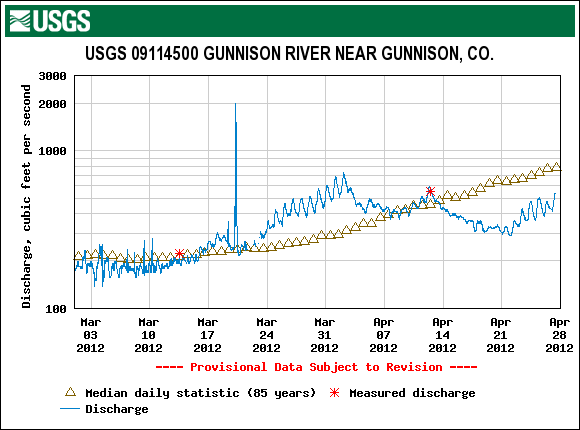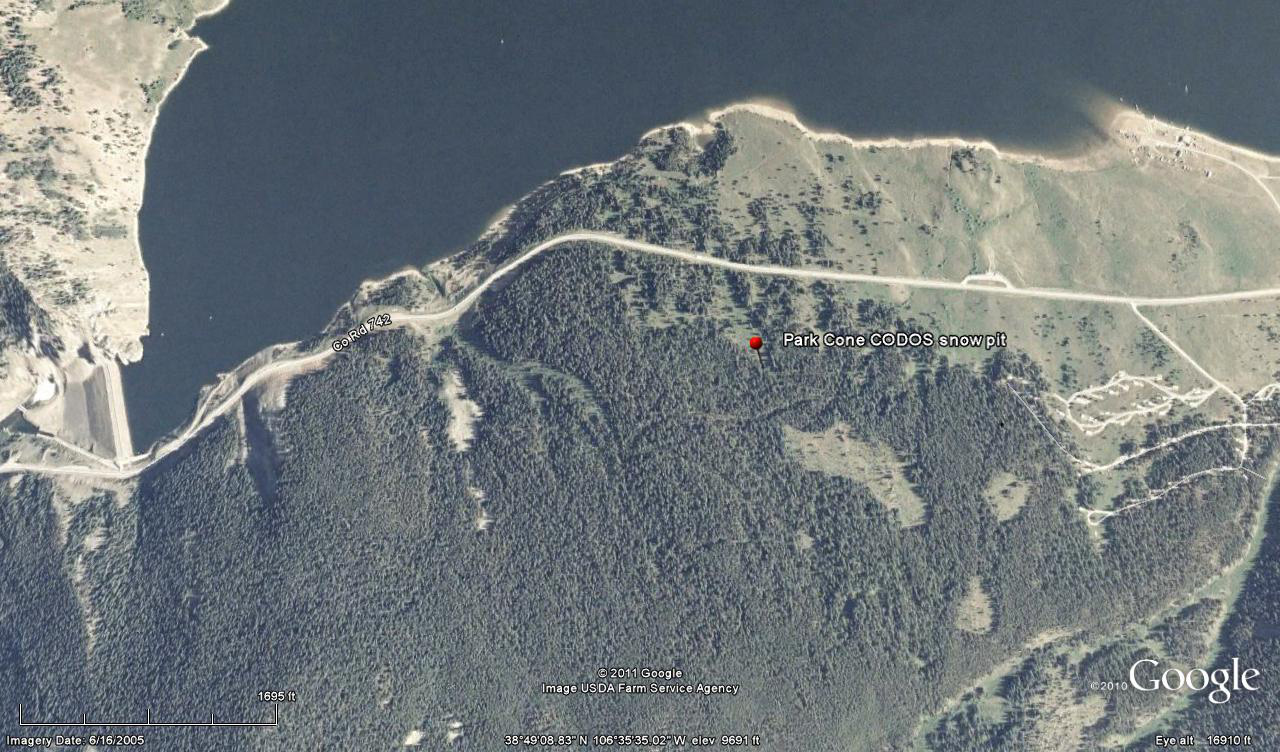 CODOS Update for Park Cone site:
CODOS Update for Park Cone site:
April 27, 2012
Summary |
Snowpack |
Melt Rate |
Stream Flows |
Forecast |
Previous Update
Summary
The Park Cone CODOS snowpit site, in an open meadow immediately adjacent to the Park Cone Snotel, was rapidly approaching “snow all gone” (SAG) on April 9 and lost snowcover soon thereafter. All dust layers were merged at the snowpack surface but dust concentrations and albedo reductions were the weakest observed during the April 5-12 field sessions at CODOS sites. After some small additions of new snow and SWE in mid-April, the Park Cone Snotel itself is now on the verge of SAG as well, and the Upper Taylor Snotel site reached SAG just after April 9th. The Schofield Pass Snotel is also tracking toward a very early date of SAG. These early dates of SAG rival (Park Cone) or could precede (Schofield) the earliest dates for SAG in the period of record at those sites.
Given the early loss of this season’s scant low elevation snowcover, snowmelt runoff is now dependent on the snowcover remaining largely above the Snotel network, in sub-alpine and alpine terrain. As observed during our early April CODOS circuit, desert dust is present, in varying concentrations, in the snowpack at those elevations throughout the State. A late April surge in streamflows included the influence of re-emergent dust as clean new snow deposited in mid-month was ablated by very warm and generally sunny weather. Recent unsettled, showery, and cooler weather, with some fresh snow, has not yet substantially slowed or reversed that surge in runoff. A return to sunny and dry weather will produce a more-or-less quick return to accelerating streamflows, depending on the depth of burial by clean new snow of the merged D8-D4 dust layer, locale by locale.
SnowPack Discussion
All snowcover is gone from the Park Cone CODOS snowpit site; no new snowpit data since April 9, 2012. Our previous Park Cone Update contains the season's snowpack profiles and snowcover photos.
Melt Rate
Gradual melt rates, and even small gains in SWE, prevailed at the Park Cone Snotel before SWE losses began to accelerate on April 18th. From April 18th to 26th melt rates averaged 0.58”/day, enhanced by the re-emergence of dust, with a maximum rate of 1”/day (for one 24-hour period). However, in part due to the early date of Peak SWE at Park Cone, at 8.1” from March 19th through March 27th, the mean daily rate of snowmelt from Peak SWE to SAG was just 0.26”/day, a lower rate than observed in prior years. Since Peak SWE at Upper Taylor, at 10.5” from March 4th through March 7th, the mean daily rate of snowmelt to SAG was ~0. 3”/day and several single 24-hour periods lost 0.9-1.0”. At the Schofield Pass Snotel, melt rates have recently been as high as 1.4”/day, with nearly 11” of SWE still remaining (see Schofield SWE table).
Stream Flows
Following an early April surge ending soon after our site visit, declining local streamflows in mid-April on the East River and the Gunnison corresponded with a period of unsettled, cooler weather and small snowfalls, and a restoration of higher snow albedo. Beginning on/about April 20, under a very strong high pressure regime bringing very warm and generally sunny weather, recent (clean) new snow was ablated by heating at the surface and, as the clean snow layer thinned and radiation penetrated that clean snow, by direct absorption of solar radiation in the dust underneath. As a result of that combination of very warm weather and reduced snow albedo, melt rates accelerated and stream flow surged again for several days but discharge remained well below median levels on the USGS’s Gunnison River at Gunnison gauge, or just at median levels on the East River.
As of this writing Friday morning, April 27th, that recent upward ratcheting in discharge shows little effect from the return to unsettled, cloudy, and cooler weather in the past 24 hours. There may be a delayed effect due to travel time from the snowmelt source area, and/or precipitation at lower elevations may have contributed to discharge. The next episode of sustained sunny and dry weather will, depending on the depth of any clean new snow recently deposited on the remaining snow covered terrain, more-or-less quickly re-expose the old, low-albedo snow surface, resuming enhanced snowmelt runoff rates.
Forecast
The National Weather Service Grand Junction office expects cooler and drier air to replace scattered snow and rain showers by later today. Another comparatively dry system passes through Colorado on Sunday as near-normal temperatures return. Then, partly or mostly sunny weather brings a return to above-average temperatures under zonal, westerly flow early in the week, but with some continued chances for scattered showers. A system from the Pacific Northwest may deliver additional precipitation to northern Colorado from mid-day Tuesday into Wednesday.

